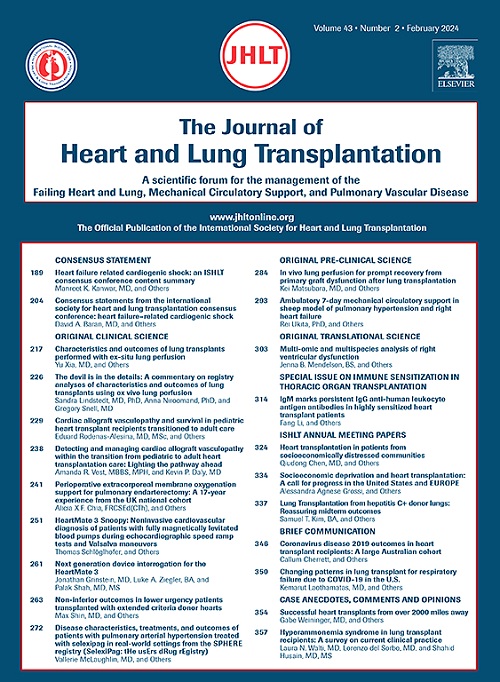心源性休克急性肢体缺血的相关因素及下游临床结果:心源性休克工作组的见解。
IF 6.4
1区 医学
Q1 CARDIAC & CARDIOVASCULAR SYSTEMS
引用次数: 0
摘要
背景:描述心源性休克(CS)患者急性肢体缺血(ALI)的发生率和后果的数据有限:我们采用了心源性休克工作组(CSWG)的数据,这是一个包括 33 个研究机构的联盟。我们建立了一个多变量逻辑回归模型来研究临床因素与 ALI 之间的关系,并建立了另一个逻辑回归模型来确定 ALI 与死亡率之间的关系:共有 7,070 名 CS 患者,其中 399 人(5.6%)出现了 ALI。ALI患者中女性(40.4%对29.4%)和患有外周动脉疾病(13.8%对8.3%)的比例更高。根据 SCAI 休克的最大分期进行分层,ALI 的发生率分别为 B 期 0.0%、C 期 1.8%、D 期 4.1%、E 期 10.3%。ALI风险较高的相关因素包括:外周血管疾病 OR 2.24(95% CI:1.53 - 3.23;P < 0.01)和≥ 2 个机械循环支持(MCS)装置 OR 1.66(95% CI:1.24 - 2.21;P < 0.01)。ALI在VA-ECMO患者(11.6%)或VA-ECMO + IABP/Impella CP(16.6%)中最高,但远端灌注导管的使用率低于50%。无 ALI 的 CS 患者死亡率为 38.0%,而有 ALI 的 CS 患者死亡率为 57.4%。ALI与死亡率明显相关,调整后OR值为1.40(95% CI 1.01 - 1.95,P < 0.01):CS患者的ALI发生率为6%。结论:CS 患者的 ALI 发生率为 6%,与 ALI 最相关的因素包括外周血管疾病和多个 MCS 装置。ALI的下游后果非常严重,死亡风险大大增加。本文章由计算机程序翻译,如有差异,请以英文原文为准。
Factors associated with acute limb ischemia in cardiogenic shock and downstream clinical outcomes: Insights from the Cardiogenic Shock Working Group
Background
There are limited data depicting the prevalence and ramifications of acute limb ischemia (ALI) among cardiogenic shock (CS) patients.
Methods
We employed data from the Cardiogenic Shock Working Group (CSWG), a consortium including 33 sites. We constructed a multi-variable logistic regression to examine the association between clinical factors and ALI, we generated another logistic regression model to ascertain the association of ALI with mortality.
Results
There were 7,070 patients with CS and 399 (5.6%) developed ALI. Patients with ALI were more likely to be female (40.4% vs 29.4%) and have peripheral arterial disease (13.8% vs 8.3%). Stratified by maximum society for cardiovascular angiography & intervention (SCAI) shock stage, the rates of ALI were stage B 0.0%, stage C 1.8%, stage D 4.1%, and stage E 10.3%. Factors associated with higher risk for ALI included: peripheral vascular disease OR 2.24 (95% CI: 1.53–3.23; p < 0.01) and ≥2 mechanical circulatory support (MCS) devices OR 1.66 (95% CI: 1.24–2.21, p < 0.01). ALI was highest for venous-arterial extracorporeal membrane oxygenation (VA-ECMO) patients (11.6%) or VA-ECMO + intra-aortic balloon pump (IABP)/Impella CP (16.6%) yet use of distal perfusion catheters was less than 50%. Mortality was 38.0% for CS patients without ALI but 57.4% for CS patients with ALI. ALI was significantly associated with mortality, adjusted OR 1.40 (95% CI 1.01–1.95, p < 0.01).
Conclusions
The rate of ALI was 6% among CS patients. Factors most associated with ALI include peripheral vascular disease and multiple MCS devices. The downstream ramifications of ALI were dire with a considerably higher risk of mortality.
求助全文
通过发布文献求助,成功后即可免费获取论文全文。
去求助
来源期刊
CiteScore
10.10
自引率
6.70%
发文量
1667
审稿时长
69 days
期刊介绍:
The Journal of Heart and Lung Transplantation, the official publication of the International Society for Heart and Lung Transplantation, brings readers essential scholarly and timely information in the field of cardio-pulmonary transplantation, mechanical and biological support of the failing heart, advanced lung disease (including pulmonary vascular disease) and cell replacement therapy. Importantly, the journal also serves as a medium of communication of pre-clinical sciences in all these rapidly expanding areas.

 求助内容:
求助内容: 应助结果提醒方式:
应助结果提醒方式:


